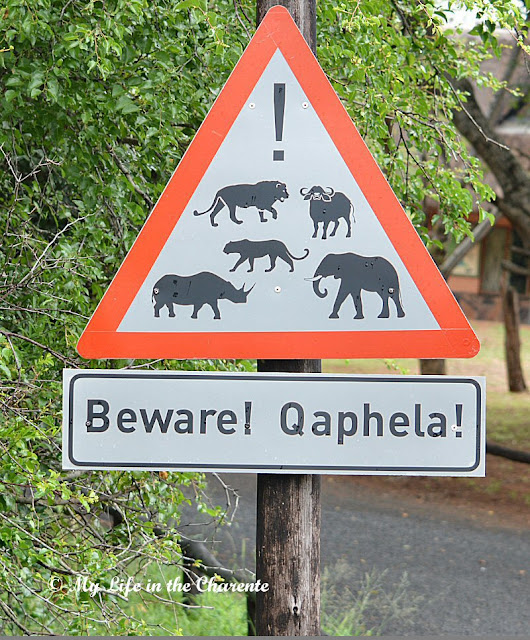Continuing on from part 8, still with Gordon and Julie.....
As we approached the entrance gate of Mkhuze Game Reserve, which is situated in northern KwaZulu-Natal, we were thankful that Gordon's Toyota had 4 wheel drive! You can get an idea of how much rain had recently fallen, by the amount of floodwater crossing the road. That section of road is in concrete for a good reason!
Our accommodation for the night! Sleeping quarters in the raised tent on the left and the kitchen on the right. Simple but effective!
Inside the tent now, with a shower and toilet through the bamboo cane decorated door on the left - all mod cons!
A night-time visitor to the kitchen, attracted by the prospect of food! There were quite a number of them in the trees around our tent. Bush babies (or Brown greater galago (Otolemur crassicaudatus) are mainly nocturnal, their large eyes giving them good night vision. Also they have strong hind limbs for leaping from tree to tree, acute hearing, and long tails that help them balance. Their bat-like ears allow them to track insects in the dark;they catch them either on the ground or snatch them out of the air! Fascinating and incredibly agile animal!
"Do not feed the animals!" - not easy when there is a thief in our midst creeping into the kitchen!!!
Nyala male (Tragelaphus angasii). The handsome slate-brown shaggy coat is marked with white vertical stripes and spots on the flanks. Males (or Rams ) appear more charcoal-grey in colour and have long inward curved horns and a white chevroned face.....
The females are browner, do not have horns, and are very much smaller than the male.
Impala male (Aepyceros melampus) It is one of the most common and most graceful of all Africa’s antelopes. A slender, agile creature, it can clear formidable obstacles and run at speeds faster than 60km/h. Only the males have horns.
Trumpeter Hornbill (Bycanistes bucinator) It is a sociable bird, usually living in groups of two to five individuals, although sometimes as many as fifty. It is a locally common resident of the tropical evergreen forests. They eat fruit or large insects.
African helmeted turtle (Pelomedusa subrufa), also known as the marsh terrapin. They eat almost anything (!) including carrion and can be found throughout Africa in rivers, dams and lakes.

The white-faced whistling duck (Dendrocygna viduata). A common bird that lives in large flocks.

The white-faced whistling duck (Dendrocygna viduata). A common bird that lives in large flocks.
Great White Pelican on the water (Pelecanus onocrotalus). This is an enormous waterbird, mostly white with short legs and a massive, broad and very long azure blue bill, which has a central red stripe and ends in a small, red hook. The mostly white bird has contrasting black flight feathers on the wings. Their diet is mainly fish, but they do feed on insects and small mammals as well.
Red-billed oxpecker (Buphagus erythrorhynchus) on a giraffe. They feed almost exclusively on ticks or insects collected from the skin of large African mammals. See my previous posts for more information!
Blue Wildebeest also called gnu, a genus of antelopes, (Connochaetes taurinus). They generally congregate in herds and both sexes have horns, though the female is smaller in size than the male.
African White-backed Vulture (Gyps africanus). It is very typical, with its bald head, broad wings and short tail. Their main food source comprises dead animals around its habitat. They are on the endangered list, mainly because of urbanisation, poisoning and use of their body parts in witchcraft.
Yellow-throated longclaw (Macronyx croceus) is found in most of Africa. Usually in pairs or small groups feeding off insects.
Burchell's Coucal (Centropus burchellii), is a species of cuckoo. This common resident of southern Africa is usually seen either as a solitary individual or in pairs, often making their way by clambering through the riverine or coastal bush. In this habitat they are often hard to see.The female lays 3 to 4 eggs and both male and female help with feeding the chicks. This bird has a very distinctive call, and it calls often before, during and just after heavy rain, thus its popular name of the Rainbird!
Nile crocodile (Crocodylus niloticus) is the largest freshwater predator ... It is one of the most dangerous species of crocodile and is responsible for hundreds of human deaths every year.. .
The red-crested korhaan or red-crested bustard (Lophotis ruficrista) feeds on insects, seeds and fruit. They are usually solitary or in pairs and they can stand very still, relying on camouflage for concealment. We were lucky that Gordon's sharp eyes saw this bird quite close to the gravel road.
Finally, the views all around in KwaZulu-Natal (the land of 1000 hills) are spectacular.
This covers most of our travel in Southern Africa, but I still have many photos that I may put on at a later date!!
Happy holidays
I would like to wish all my followers who celebrate Christmas the very
best over the holidays!
I am going into blog hibernation until well into the New Year. We are off to see friends in Nevis for two weeks, then we will have a quiet Christmas in the UK with my FIL. Meanwhile I will try to keep the PhotoDiary going when possible.
Take care everyone; see you all after the holidays.







































































